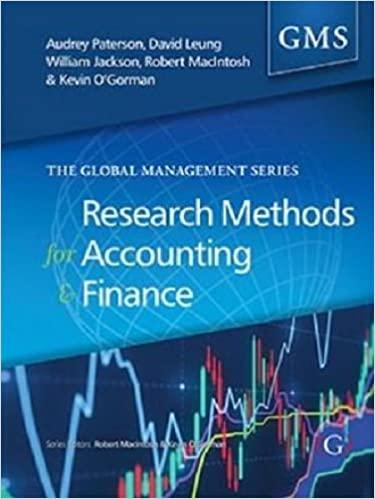Question
Need Help To Solve Solution to each Multiple Choice: 5. The conceptual framework approach is used to evaluate independence matters in Topic 1.210. The Code
Need Help To Solve Solution to each Multiple Choice:
5. The conceptual framework approach is used to evaluate independence matters in Topic 1.210. The Code uses
| A risk-based approach to assess whether a CPAs relationship with a client would pose an unacceptable risk | |
| An independence in fact as opposed to an independence in appearance approach to assess when independence is at an unacceptable risk level |
| Family relationships to determine in all cases whether independence is impaired | |
| Safeguards to protect from all independence risks |
| Members of the AICPA to determine when independence is i6.mpaired |
6. If a CPA who is a member of the AICPA violates the AICPA Code of Professional Conduct, what disciplinary action may the AICPA take against the member?
| Revoke the individuals membership in the AICPA and revoke the members license to practice as a CPA | |
| Revoke the members authorization to conduct audits of SEC reporting companies |
| Revoke the members authorization to conduct audits of privately held companies | |
| Revoke the individuals membership in the AICPA only, the member may still practice as a CPA and may still conduct audits of SEC reporting and privately held companies if there is no other action taken |
| None of the above |
7. What may result in a CPA losing his/her license to practice as a CPA?
| Violating the AICPA Code of Professional Conduct | |
| Violating the State Society of CPAs Code of Professional Conduct |
| Violating the State Board of Accountancys Code of Professional Conduct which may be identical to the AICPA Code of Professional Conduct | |
| Violating any of the professional codes established by any of the various accounting organizations |
| None of the above |
8. Topic 1.200 of the AICPA Code of Professional Conduct requires independence for
| All engagements conducted by a CPA | |
| All attest engagements conducted by a CPA |
| All attest and tax engagements conducted by a CPA | |
| All work of any kind done by a CPA |
| None of the above |
9. Independence in appearance means the member
| Should avoid situations where the members potential lack of independence can be observed by others | |
| Should avoid circumstances where the member is seen at a social function with an audit client |
| Should avoid situations where the member is in fact not independent | |
| Should avoid circumstances that might cause an informed third party to reasonably conclude that the integrity, objectivity, or professional skepticism of a member has been compromised |
| Should only be a problem for audit clients that are publicly held companies |
10. The AICPA Code of Professional Conduct deals with the general standard of competence. This standard would hold that if a member in public practice who has audited privately held, for-profit companies, is asked to audit a local school district and has never audited a school district before, the member should
| Accept the engagement, a school district audit is not that different from a for-profit company audit | |
| Accept the engagement knowing he can take a continuing professional education course from the AICPA to learn how to audit a school district before the audit is scheduled to start |
| Accept the engagement knowing there is very little audit risk | |
| Accept the engagement knowing that the school district does not have much money and will not be able to hire another CPA to do the required audit |
| Refuse the engagement
|
Step by Step Solution
There are 3 Steps involved in it
Step: 1

Get Instant Access to Expert-Tailored Solutions
See step-by-step solutions with expert insights and AI powered tools for academic success
Step: 2

Step: 3

Ace Your Homework with AI
Get the answers you need in no time with our AI-driven, step-by-step assistance
Get Started


